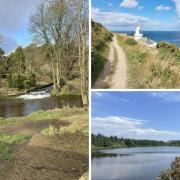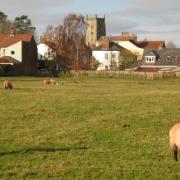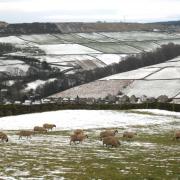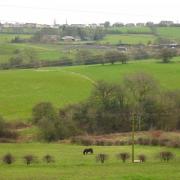This month's walk takes us from the hometown of a great explorer to a much loved countryside landmark
If upbringing counts for anything James Cook should have become a mountaineer rather than a great sailor, explorer and discoverer of Australia and Hawaii, among other islands. He was born at Marton, which today is a suburb or Middlesbrough, but grew up in Great Ayton in the shadow of Roseberry Topping. At a little over 1,000ft, it may not be the tallest hill in Yorkshire but it’s arguably the most charmingly named and has a strong claim to be the shapeliest too.
It is too small to tower over the village but it draws the eye irresistibly to its neat pyramid and would have been a familiar sight to the young James when he was at school here or working on a local farm as he did before being apprenticed to a grocer in the coastal village of Staithes. He quickly decided retail life was not for him and moved to Whitby, learning his seafaring trade on coasters and sailing across the North Sea to Scandinavia.
He joined the Royal Navy in 1755, seeing action against the French off Canada in the Seven Years War and went on to map the coasts of Newfoundland, New Zealand and Australia before being killed in a skirmish in Hawaii in 1779.
Great Ayton still honours its most famous son and a statue of a young Cook stands on High Green in the centre of the village. It is a much more playful depiction than the better-known portraits of the stern mariner.
Directions
This walk sets off from there to climb Roseberry before crossing to visit the tall sandstone obelisk which honours his memory. You can still visit his old school but the family home was dismantled in 1934 and shipped to Melbourne, Australia where it was rebuilt brick by brick.
From the statue on High Green turn right passing a row of shops and the Post Office and curve into Newton Road. After 100yds a black iron gate with a public footpath sign leads through the stone wall on the right. After crossing fields and copses the path reaches a single track railway. Cross this with care and press on up the hill on the still-enclosed track.
At a crossroads of paths by a National Trust sign take the narrow path slanting half right uphill and signed to Cliff Rigg Quarry, which was last worked in 1973 and now provides a haven for wildlife. After a short climb the path leaves the woods at a stile. Turn left towards another stile in the field corner and then immediately right to follow the wire fence towards the shapely cone of Roseberry Topping.
From its rocky summit there is a panoramic view of the northern escarpment of the Cleveland Fells and a somewhat less picturesque, if no less impressive, view of industrial Teesside. To the east the slender finger of Captain Cook’s monument provides the next objective.
From the summit follow the path down into the dip and them up the other slope to reach a gate in a stone wall. Take the rightwards fork following a stone wall by a wood. The broad path, part of the Cleveland Way, curls around the wood and heads towards the monument. But first the path drops down a flight of stone steps to the gap of Gribdale Gate before a final climb through the trees.
The monument, a sandstone obelisk on Easby Moor, stands more than 50ft high and is a landmark for miles around. It was erected by Robert Campion of Whitby in 1827and bears the words: ‘In memory of the celebrated circumnavigator Captain James Cook FRS a man in nautical knowledge inferior to none, and in zeal, prudence and energy superior to most.’ It offers more sweeping views, including back top Roseberry Topping and is an ideal place to stop for a final break before the descent to Great Ayton.
From the monument head away half right along a track which makes for a pair of stone gateposts. Pass through these and follow the path along the escapement for about 100yds until a discreet yellow arrow at ground level points half left down another narrow track which angles across the moorside. This leads to a very steep descent through the trees where nimbleness can prove an asset.
Cross straight over another path and drop down to another gate where a handy bench allows a breather while admiring the view of Great Ayton and Roseberry Topping. Drop downhill about a hundred yards to where another track crosses. Turn right and follow this diagonally down the slope, across fields and through woods to eventually emerge on a tarmac lane. When it reaches Aireyholme Lane turn left and follow this quiet country road down into Great Ayton. At the roundabout turn right which leads swiftly back to the Post Office and the green.
Compass Points
Start/Finish: High Green, Great Ayton.
Distance: 7 miles/11kms
Height gain: 1,100ft/340m.
Time: 3 hours
Terrain: Field paths and moorland tracks. Steep climb to Roseberry Topping and a sharp descent from the Monument
Refreshments: Great Ayton.
Map: OS OL26 North York Moors (Western)


























